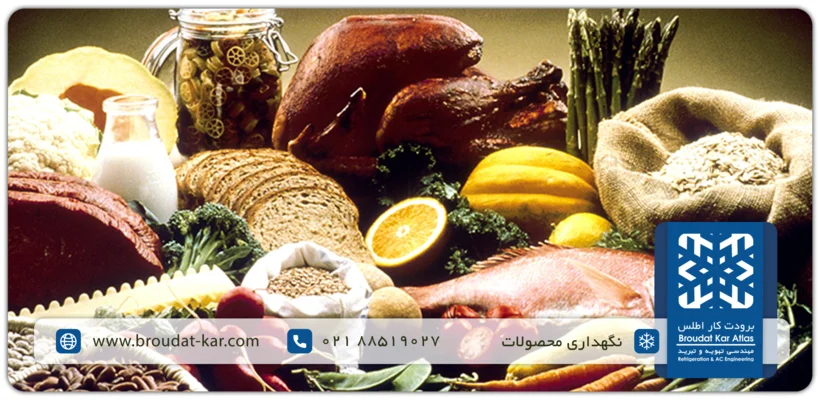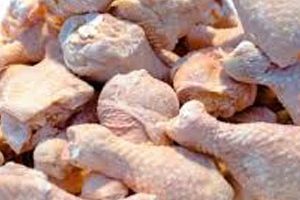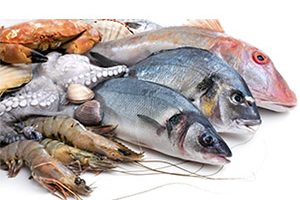Maintaining the Shelf Life of Products through Cold Storage Temperature Control
Adhering to prescribed cold storage temperatures is paramount for preserving product quality over time. Optimal utilization of cold storage necessitates meticulous handling and transportation practices to uphold product integrity. The temperature guidelines outlined in the table below are tailored for the extended storage of these products. For shorter storage durations, slightly higher temperatures may be permissible. It’s important to clarify that the temperatures listed refer to the product’s internal temperature, not the ambient air temperature within the cold storage facility. Thus, to achieve the desired product temperature, the cold room should be maintained several degrees cooler than the product itself.
Products are susceptible to rapid spoilage at elevated temperatures compared to lower temperatures. Hence, expeditious heat removal through cooling to an appropriate storage temperature significantly extends the market life of the product.
Below, you’ll find tables detailing the requisite relative humidity, respiration rate, and cold storage temperatures for various products.

Call us for free consultation on refrigeration equipment
Table of Storage Conditions for Various Fruits and Vegetables in Cold Storage
| Row | Product Type | Storage Temperature (in degrees Celsius) | Relative Humidity (Percentage) | Approximate Postharvest Life |
| 1 | Fennel | 0-2 | 90-95 | |
| 2 | Apple | 4to-1 | 90-95 | 12Months |
| 3 | Apricot | 0 | 90-95 | 1Month |
| 4 | artichoke | 0 | 95-100 | |
| 5 | Asparagus | 2/5 | 95-100 | |
| 6 | Avocado | 12 | 85-90 | |
| 7 | Banana | 12to15 | 90-95 | 1Month |
| 8 | Green Beans | 4to7 | 95 | 10Days |
| 9 | Beans | 0 | 90-95 | 10Days |
| 10 | Beet | 0 | 98-100 | 5Months |
| 11 | Black Berry | 0to-0.5 | 90-95 | 3Days |
| 12 | BlueBerries | 0to-0.5 | 90-95 | |
| 13 | Black Berry | 0to-0.5 | 90-95 | 3Days |
| 14 | Raspberry | 0to-0.5 | 90-95 | 3Days |
| 15 | Broccoli | 0 | 95-100 | 15Days |
| 16 | Lettuce | 0 | 95-100 | 3Weeks |
| 17 | Carrot | 0 | 98-100 | 2Weeks |
| 18 | Cauliflower | 0 | 95-98 | 1Month |
| 19 | Celery | 0 | 98-100 | 3Months |
| 20 | Cherry | 0 | 90-95 | 3Weeks |
| 21 | Chives | 0 | 95-100 | |
| 22 | Cilantro | 0to2 | 95-100 | |
| 23 | Grapefruit | 14to15 | 85-90 | 1Year |
| 24 | Lemon | 10to12 | 85-90 | 3Weeks |
| 25 | Sour Lemon | 8to10 | 85-90 | 3Weeks |
| 26 | Orange | 0to4 | 85-90 | 4Weeks |
| 27 | Blood Orange | 4to7 | 90-95 | 2Weeks |
| 28 | Tangerine | 7to10 | 85-95 | 2Months |
| 29 | Coconut | 0to2 | 80-85 | |
| 30 | Corn | 0 | 95-98 | 10Days |
| 31 | Cucumber | 10to12 | 85-90 | 15Days |
| 32 | Raisins | 0 | 90-95 | |
| 33 | Date | 0to-17 | 75 | |
| 34 | Eggplant | 10-12 | 90-95 | 10Days |
| 35 | Garlic | 0 | 65-70 | 7Months |
| 36 | Ginger | 13 | 65 | |
| 37 | Grape | 0to0.5 | 90-95 | 3Months |
| 38 | Basil | 10 | 90 | |
| 39 | Mint | 0 | 95-100 | |
| 40 | Oregano | 0to5 | 90-95 | |
| 41 | Parsley | 0 | 95-100 | 2Months |
| 42 | Thyme | 0 | 90-95 | |
| 43 | Jujube | 2.5to10 | 85-90 | |
| 44 | Mango | 12 | 85-90 | |
| 45 | Cantaloup | 2to5 | 95 | |
| 46 | Mushrooms | 0 | 90 | 5Days |
| 47 | Nectar | 0to-0.5 | 90-95 | 1Month |
| 48 | Okra | 7to10 | 90-95 | 10Days |
| 49 | Olive | 5to10 | 85-90 | |
| 50 | Onion | 0 | 65-70 | 2Months |
| 51 | Peach | 0to-0.5 | 90-95 | 1Month |
| 52 | Peas | 0to1 | 90-98 | |
| 53 | Bell Pepper | 7to10 | 95-98 | 15Days |
| 54 | Persimmon | 0 | 90-95 | 5Weeks |
| 55 | Pineapple | 7to12 | 85-90 | |
| 56 | Plum | 0to-0.5 | 90-95 | 5Weeks |
| 57 | Pomegranate | 5 | 90-95 | 4Weeks |
| 58 | Potato | 4to12 | 95-98 | |
| 59 | Squash | 12.5to15 | 50-70 | 3Months |
| 60 | Quince | 0to-0.5 | 90 | |
| 61 | Barberry | 0to1 | 90 | |
| 62 | Radish | 0 | 95-100 | 2Months |
| 63 | Rhubarb | 0 | 95-100 | 1Month |
| 64 | Persian Shallot | 0to2 | 65-70 | |
| 65 | Spinach | 0 | 95-100 | 15Days |
| 66 | Soft Skin Pumpkin | 7to10 | 95 | 2Weeks |
| 67 | Pumpkin With Thick Skin | 12to15 | 50-70 | 6Months |
| 68 | Tamarind | 2to7 | 90-95 | |
| 69 | Green Tomatoes | 10to12 | 90-95 | 1Month |
| 70 | Ripe Tomatoes | 7to10 | 85-90 | 10Days |
| 71 | Hazelnut | 0to2 | 85-90 | |
| 72 | Watermelon | 10to15 | 90 | 2Weeks |
| 73 | Strawberry | 0 | 90-95 | 1Weeks |
| 74 | Kiwi | 0 | 90-95 |
| Row | Product | Shelf Life in Cold Storage | Storage Temperature Range | Required Humidity |
| 1 | Milk | 5 to 7 days | 0 °C to 4°C | 85% |
| 2 | Cream | 5 to 7 days | 0 °C to 4°C | 85% |
| 3 | Packaged Ice Cream | 2 to 4 months | -18 °C to -22°C | 85% |
| 4 | Ice Cream | 2 to 6 weeks | -18 °C to -22°C | 85% |
| 5 | Cheese | Several weeks to one year | 2 °C to 7°C | 80-90% |
| 6 | Butter | Several Months | -18 °C to -22°C | 80% |
| 7 | Yogurt | 7 to 15 days | 0 °C to 4°C | 85% |
The aforementioned tables have been compiled by Atlas Refrigeration, drawing from reputable global sources, notably the 2002 ASHRAE Handbook Refrigeration.
Related posts
Ideal Cold Storage Temperature Of Food Products
Portable Cold Store; Design and Construction of Portable Cold Store + Price The portable cold room, also known as
What Is Meat Cold Storage? Meat cold storage, also known as a meat refrigeration facility, is a specialized center dedicated
What is dairy cold storage? Dairy cold storage stands as a pivotal element within the dairy industry, crucial for the
What Is Chicken Cold Storage? Chicken cold storage refers to specialized equipment designed for preserving poultry products like chicken
Fish and Shrimp Cold Storage Systems – Preserving Freshness Fish and shrimp cold storage facilities play an important role in
What is Fruit Cold Storage? A Fruit cold storage is a specialized facility designed to store fruits and vegetables






